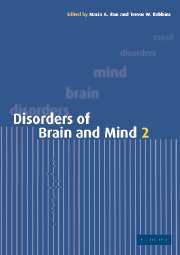Book contents
- Frontmatter
- Contents
- List of contributors
- Preface
- Part I Genes and behaviour
- Part II Brain development
- Part III New ways of imaging the brain
- Part VI Imaging the normal and abnormal mind
- Part V Consciousness and will
- Part IV Recent advances in dementia
- Part VII Affective illness
- Part VIII Aggression
- 17 Human aggression: biological correlates and environmental influences
- 18 A neurocognitive model of the psychopathic individual
- Part IX Drug use and abuse
- Index
- Plate section
- References
17 - Human aggression: biological correlates and environmental influences
from Part VIII - Aggression
Published online by Cambridge University Press: 19 January 2010
- Frontmatter
- Contents
- List of contributors
- Preface
- Part I Genes and behaviour
- Part II Brain development
- Part III New ways of imaging the brain
- Part VI Imaging the normal and abnormal mind
- Part V Consciousness and will
- Part IV Recent advances in dementia
- Part VII Affective illness
- Part VIII Aggression
- 17 Human aggression: biological correlates and environmental influences
- 18 A neurocognitive model of the psychopathic individual
- Part IX Drug use and abuse
- Index
- Plate section
- References
Summary
Introduction
Aggression is a term used to describe broad classes of behaviour, although it is most typically used within the context of a social interaction. Many definitions of aggressive behaviour have been offered (see Kaufmann 1965), but one of the most widely cited definitions states that an aggressive response is ‘a response that delivers noxious stimuli to another organism’ (Buss 1961). This definition does not distinguish between different functional classes of behaviour, such as responding maintained by money or harm produced to others (i.e. positive reinforcers) or responding maintained by escape from aversive situations (i.e. negative reinforcers), but it encompasses the most salient feature of aggressive responding, and equally important, provides an operational definition of aggressive responding which is essential for aggression research.
Although overall rates of violent behaviour have remained fairly constant across the last few decades, incidents of violence among younger people have shown a significant increase (Potter and Mercy 1997). The costs of such antisocial behaviour to the aggressive individual, to his or her family and to society can be severe and include the disruption of the offender's social relations, the harm to the recipient and the enormous monetary costs associated with social services and the judicial system (see Kazdin 1987). Identifying the environmental and biological variables that influence aggressive responding thus remains an important task for researchers and clinicians, as these variables will provide the framework for the reduction and prevention of harmful aggressive behaviour.
- Type
- Chapter
- Information
- Disorders of Brain and Mind , pp. 375 - 399Publisher: Cambridge University PressPrint publication year: 2003
References
- 1
- Cited by



